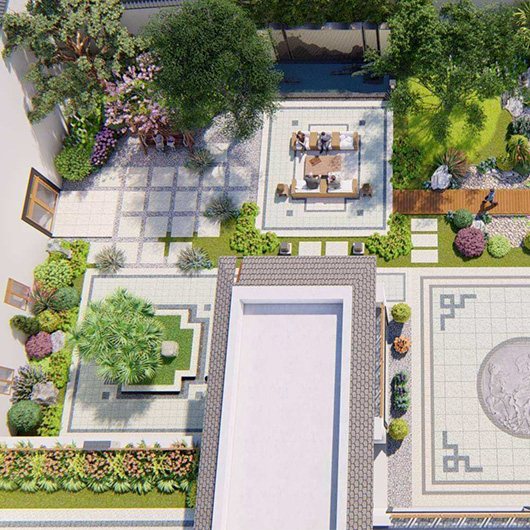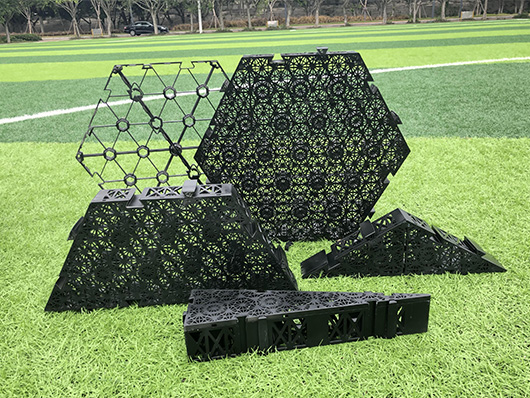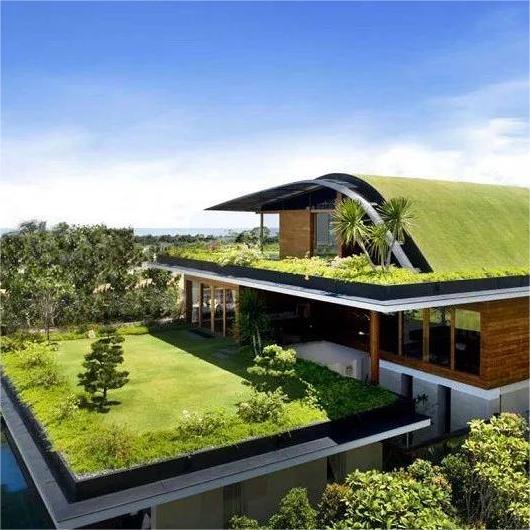Roof greening
Green Roof Technology and Implementation Key Points
Roof greening generally refers to roofs, walls, terraces, underground garages, hard floors, overpasses and other greenings that are out of the ground. Greening of exposed mountain slope protection is also a kind of roof greening. It is an effective way to control “urban diseases”.

Several Mature Technologies of Roof Greening
-
Roof lawn
Light green roof or pure ecological roof green is also called roof lawn. Roof turf has relatively low requirements on roof load, and the added weight is less than 30-70kg/㎡, which is suitable for almost all kinds of roofs. It can achieve rapid construction and immediate results. In addition, it is easy to manage, low in construction and maintenance costs, and can maintain a good landscape effect as long as some irrigation is carried out after completion. At the same time, the ecological effect is very significant. Therefore, in cities with many original buildings, roof lawns are more suitable for large-scale promotion and application.
The roof lawn construction procedure is as follows:
- Investigate load bearing: the roof load can be implemented if the load per square meter is ≥70kg.
- Closed water test: Clean the roof and the next process can only be started after the closed water test does not leak. If the roof leaks, you must first make a waterproof layer.
- Laying of garden roads and outfalls: According to the design drawing, set the drainage pattern, build planting fences and work channels, and pay special attention to the flow direction of water and the smoothness of outfalls.
- Lay the separation sliding layer: Use special plastic cloth and non-woven fabric to cover the planting enclosure, with an overlap width of more than 10cm. Extend it to the enclosure, at the same height as the enclosure bricks.
- Lay light nutrition matrix: the thickness is 8cm to 10cm; the matrix preparation should be based on the climatic conditions of each place, and the appropriate ratio should be obtained from the test.
- Planting: Sedum plants should be used for the roof lawn, such as Sedum, which is resistant to drought, high temperature, good water-saving performance, cold-resistant in winter, perennial root whorls, and extensive maintenance and management. The mixed species of sedum will have a richer landscape and stronger resistance. It is the preferred plant population for roof lawns.
- The recovery period is about 30 days. Two links are particularly important in maintenance: one is to water enough spring water to make the lawn turn green smoothly; the other is to water the frozen water thoroughly to help the lawn survive the winter safely.
- Clean up the construction site.
-
Sky Garden
The sky garden is similar to the garden green space on the ground. It adopts internationally accepted new techniques, new equipment, and new technologies such as waterproof barrier roots, water storage and drainage, and reasonable combination of trees and flowers, mountains, rocks, and flowing water, pavilions, corridors, bridges, and pavilions. The weight per square meter of general projects is 100-200kg, and the weight under water saturation is 300-400kg. The static load on the roof should be above 500kg per square meter.

The general process of Hanging garden construction is as follows:
- Investigation load bearing: the roof load per square meter ≥ 300kg can be implemented.
- Closed water test: Clean the roof. After the closed water test, the roof will not leak before entering the next process. If the roof leaks, the waterproof layer must be prepared first.
- Laying the root-blocking waterproof layer. It is the key technology to do a good job in the sky garden. The key point is to do a good job of waterproofing the nodes of the parapet and roofing equipment.
- Lay the drainage aquifer. The point is to do a good job at the drain to ensure smooth drainage.
- Lay the filter and isolation layer: Cover the drainage board with special non-woven fabrics, with an overlap width of more than 10cm, and extend to the enclosure, at the same height as the enclosure bricks. To choose a non-woven fabric produced by a suitable method, pay attention to the weight specification of the non-woven fabric.
- Construction of planting ponds, garden sketches and garden roads.
- Lay light nutrition matrix: the thickness is 20cm to 100cm; the matrix preparation should be based on the climatic conditions in various places, and the appropriate ratio should be obtained from the test. The best nutrient matrix currently used is artificial soil—perlite, which simulates the particle composition of soil. It adds various nutrients needed by plants, which is environmentally friendly and does not breed insects.
- Planting: choose trees, shrubs, flowers and plants that are water-saving, strong in resistance, slow in growth, beautiful in shape and rich in color, and pay attention to the planting season.
- Plants should be fixed and supported. If the tree height exceeds 2m, it should be properly supported to avoid unsafe factors caused by strong winds.
- Clean up the construction site.
- Recovery period maintenance
-
Roof gardens, orchards
Rooftop vegetable gardens and orchards not only have good ecological effects, but also have the economic effects of agricultural harvests. It adds new channels for planting, and are new ways of directional roof greening in my country. The construction methods of roof gardens and orchards are similar to those of sky gardens
Precautions and key points of roof greening construction
-
Safety comes first, load is the most important
Safety is the guarantee of roof greening and determines the success or failure of roof greening. The safety of green roofs includes the load-bearing of building structures. Every part and every link cannot be taken lightly.
The most important thing in safety is the load of the roof, which consists of static load and dynamic load. The static load is the roof load generated by the roof structure layer, green structure layer, vegetation layer, etc. The dynamic load refers to the roof load caused by snow accumulation and rainwater backflow, personnel movement and building repair. When designing the roof garden, the heavier loads such as garden sketches, pavilions, rockery. And pools should be selected on the load-bearing positions of the building (beams, columns, and load-bearing walls) as much as possible.
-
The substrate should be nutritious and environmentally friendly, and even lighter
According to the site conditions of roof greening, in addition to meeting the growth conditions of plants, the matrix layer also needs a lightweight material layer with certain permeability, water storage capacity and spatial stability. It is difficult for general soil to meet these requirements, so various media are generally used to prepare artificial soil for roof greening. The most ideal application at present is perlite artificial soil.
-
Waterproof and drainage is the key
Waterproof and drainage is the key to roof greening, so multi-channel waterproof facilities should be carried out according to the roof structure during design. The systematic treatment of waterproof and drainage structures should be done well. The roots of various plants have strong puncture ability. In order to prevent roof leakage, waterproof materials with root-blocking functions should be laid on the roof first.
HOENSOEY Cells are a new type of rainwater storage honeycomb units with ultra-high compression strength and unique buckles. They are a core component in stormwater management systems to solve water drainage problems.

There are many advantages:
- Because of its lightweight (9.2 kilograms per square meter), it will not cause damage to the roof.
- HOENSOEY Cells has large water storage capacity (8 liters per square meter).
- Rainwater can be flexibly collected, discharged or artificially supplemented according to the weather conditions;
- The irrigation of plants can be achieved without manual labor, which saves a lot of maintenance costs;
- The nutritional supplementation of the entire grassland can be achieved by adding nutrient solution at a single point.
- It can save up to 30% on overall site drainage costs compared to conventional methods.
Visit the site to learn more about HOENSOEY Cells. https://www.hoensoey.com/
